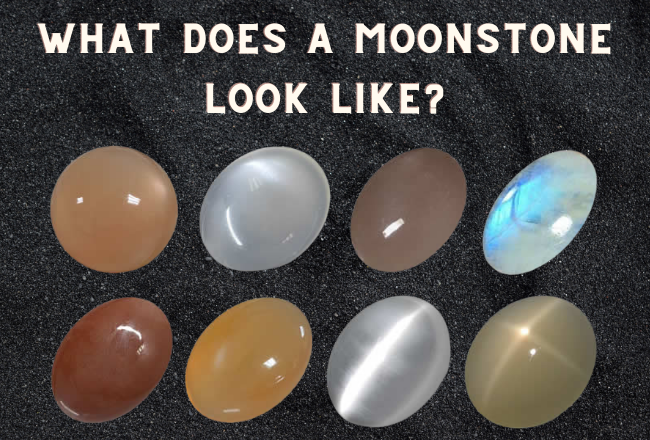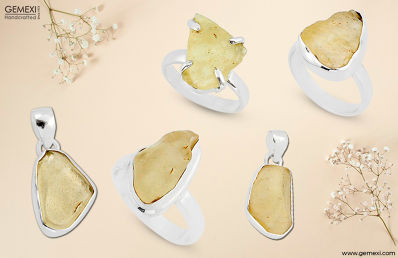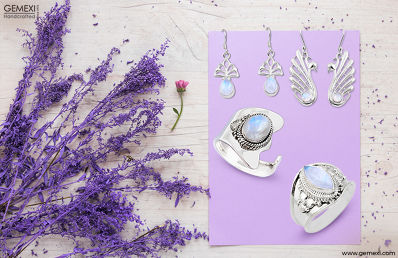What does a moonstone look like?
By Gemexi Team | Gemology- Updated On May 23, 2023

Moonstone is a type of feldspar mineral with a pearly and translucent appearance. Its color can range from white to cream, peach, gray, green, or blue.
Moonstones have a unique visual effect called adularescence, a soft, bluish-white light that appears to move across the gemstone's surface as it is rotated. This effect is caused by light scattering as it passes through thin, alternating layers of feldspar minerals within the stone.
Moonstones are often cut into cabochons, which are smooth, rounded shapes that highlight the stone's iridescence and unique color patterns. They are commonly used in necklaces, bracelets, and earrings.
Moonstones are available in different colors, from opaque to semitransparent and from white to colorless, with colorful effects like bluish, silver, or white adularescence. The colors of the moonstone may vary. They can be green, brown to yellow, or gray to black. Some moonstones also give cat’s eye effects and sometimes give four rays star-like effects, which is known as asterism.
Moonstones have a unique visual effect called adularescence, a soft, bluish-white light that appears to move across the gemstone's surface as it is rotated. This effect is caused by light scattering as it passes through thin, alternating layers of feldspar minerals within the stone.
Moonstones are often cut into cabochons, which are smooth, rounded shapes that highlight the stone's iridescence and unique color patterns. They are commonly used in necklaces, bracelets, and earrings.
Moonstones are available in different colors, from opaque to semitransparent and from white to colorless, with colorful effects like bluish, silver, or white adularescence. The colors of the moonstone may vary. They can be green, brown to yellow, or gray to black. Some moonstones also give cat’s eye effects and sometimes give four rays star-like effects, which is known as asterism.
What is Moonstone?
Moonstone is a type of mineral that belongs to the feldspar group. It is a translucent or opaque stone that exhibits a distinctive play of light known as adularescence, which appears as a shimmering or glowing effect that moves across the stone's surface. Moonstones can range from colorless to white, gray, brown, yellow, green, or pink, and they can also have a blue sheen or a cat's eye effect.
Moonstone has been used as a gemstone for centuries and prized for its mystical and metaphysical properties. In many cultures, the moonstone is believed to be a symbol of femininity and is associated with the moon and the goddess of the moon. It is also thought to have healing properties and is believed to promote emotional balance, calmness, and intuition.
Moonstone is commonly used in jewelry, particularly rings, necklaces, and earrings. It is also used in decorative objects such as vases, bowls, and statues. Moonstone is found in various parts of the world, including India, Sri Lanka, Madagascar, Myanmar, and the United States.
Some factors should be the focus on before buying any moonstone, which are as follow:
Moonstone has been used as a gemstone for centuries and prized for its mystical and metaphysical properties. In many cultures, the moonstone is believed to be a symbol of femininity and is associated with the moon and the goddess of the moon. It is also thought to have healing properties and is believed to promote emotional balance, calmness, and intuition.
Moonstone is commonly used in jewelry, particularly rings, necklaces, and earrings. It is also used in decorative objects such as vases, bowls, and statues. Moonstone is found in various parts of the world, including India, Sri Lanka, Madagascar, Myanmar, and the United States.
Some factors should be the focus on before buying any moonstone, which are as follow:
- Backside color of the stone
- Sheen orientation
- Color
These three factors will help buyers know that the moonstone jewelry they are buying is good.
What color is real moonstone?
The real moonstone comes in a variety of colors, ranging from white, cream, grey, and peach to blue, green, and rainbow. The most common and popular color for moonstones is white or a creamy white with a blue sheen. Moonstone's unique optical properties, such as adularescence or the display of a floating light effect, give it a mystical and ethereal appearance, regardless of color. Ultimately, the color of the moonstone is determined by the mineral content and lighting conditions under which it is viewed.
What are the Different Types and Colors of Moonstones?
Moonstones are typically found in a range of colors, each with its own unique properties and characteristics. Here are some of the different types of moonstones:- Blue Moonstone: This variety of moonstones has a milky, translucent blue appearance and is said to enhance intuition and psychic abilities.
- White Moonstone: White moonstones are the most common variety known for their iridescent glow. They are said to have a calming mental effect and promote emotional balance.
- Peach Moonstone: This variety of moonstones has a soft, peach-colored hue associated with the sacral chakra. It is believed to promote fertility and creativity.
- Grey Moonstone: Grey moonstones have a subtle grey tone and are said to have a grounding effect. They are believed to aid in emotional healing and promote inner strength.
- Green Moonstone: This variety of moonstones has a greenish hue and is associated with the heart chakra. It is believed to promote love and compassion.
- Rainbow Moonstone: Rainbow moonstones have a white or beige base color with blue, green, and purple flashes. They are said to have a powerful energy that promotes transformation and growth.
- Black Moonstone: This variety of moonstone has a dark, almost black appearance and is said to have a protective energy that shields against negative energy and psychic attacks.
People think moonstone quality should be shown in their color, semitransparent, or nearly transparent to colorless for a very long time. The purest moonstone is a crystal with glassy purity with an electric blue shimmer. When it comes to body color or the color of the backside of the crystal, it should be nearly colorless or have some yellowish-to-brownish tints. The sheen of the crystal should be centered on the top so that it can be seen from different angles & a wide range. The most popular moonstone variety includes yellow to an orange color known as the peach.
What color moonstone is most valuable?
The value of moonstone is determined by several factors, including its color, clarity, cut, size, and overall quality. However, the value of the moonstone is not primarily determined by its color alone.
The most valuable moonstones exhibit a blue sheen or adularescence, regardless of their base color. Moonstones with strong, vivid blue adularescence are rare and highly prized by collectors and gemstone enthusiasts. These blue moonstones are often found in Sri Lanka and are typically more valuable than moonstones with other colors or weaker adularescence.
In addition to blue adularescence, other factors that can influence the value of moonstone include its transparency, lack of inclusions, symmetry of the adularescence, and cut and shape. Ultimately, the value of a moonstone will depend on its unique combination of characteristics, and there is no single "most valuable" color of a moonstone.
The most valuable moonstones exhibit a blue sheen or adularescence, regardless of their base color. Moonstones with strong, vivid blue adularescence are rare and highly prized by collectors and gemstone enthusiasts. These blue moonstones are often found in Sri Lanka and are typically more valuable than moonstones with other colors or weaker adularescence.
In addition to blue adularescence, other factors that can influence the value of moonstone include its transparency, lack of inclusions, symmetry of the adularescence, and cut and shape. Ultimately, the value of a moonstone will depend on its unique combination of characteristics, and there is no single "most valuable" color of a moonstone.
Moonstone Clarity
Moonstone is a gemstone, usually translucent or transparent, with a milky white or bluish sheen. The term "Moonstone Clarity" refers to the level of transparency or clearness of the stone.When evaluating the clarity of Moonstone, several factors are taken into account, including the presence of internal inclusions, cracks, or other blemishes that can affect the stone's appearance and value. The clearer and more transparent the stone, the higher its clarity grade.
Moonstone with high clarity is often more valuable than those with visible inclusions or cloudiness. However, in some cases, inclusions or internal fractures may create unique patterns that can enhance the stone's beauty and add to its value.
Ultimately, the value of a Moonstone depends on a combination of factors, including its color, size, cut, and clarity, as well as any unique features that make it stand out from other stones. A perfect moonstone should be transparent and as free of incorporation as possible. Characteristics of inclusion or incorporation in the crystal may include small cracks known as centipedes. Above mentioned points will help everyone to know what the actual moonstone looks like.
Moonstone Quality Factors
Moonstone is a beautiful gemstone with a unique play of color that appears to move across the surface of the stone as it is viewed from different angles. Here are some of the quality factors to consider when evaluating a moonstone:
- Color: Moonstone occurs in a range of colors, including white, gray, peach, pink, blue, and green. The most valuable moonstones exhibit a blue or blue-green iridescence, also known as adularescence, which appears to float just below the surface of the stone.
- Transparency: Moonstone is typically translucent to opaque. Stones with a high degree of transparency are considered more valuable.
- Cut: Moonstone is usually cut into cabochons, polished, domed shapes without facets. The quality of the cut can affect the stone's overall appearance and play of color.
- Clarity: Moonstone often contains inclusions, which can affect its transparency and overall appearance. Stones with fewer inclusions are considered more valuable.
- Carat weight: Moonstone is not particularly dense, so larger stones are relatively common. However, larger stones with high-quality play of color are rarer and more valuable.
- Origin: Moonstone is found in many locations around the world, including India, Sri Lanka, Madagascar, Myanmar, and the United States. Some sources are known for producing higher-quality moonstones than others, which can affect their value. For example, Sri Lankan moonstones are highly prized for their blue adularescence.
Who should wear a moonstone?
Moonstone is considered a highly spiritual and mystical gemstone and is believed to have several beneficial properties. Here are some individuals who may benefit from wearing a moonstone:- Those seeking emotional balance and stability: Moonstone is believed to have a calming effect on emotions, making it a good choice for individuals who struggle with anxiety, stress, or mood swings.
- Expectant mothers: Moonstone is said to promote fertility and aid in a healthy pregnancy, making it a popular choice for expectant mothers.
- Spiritual seekers: Moonstone is believed to enhance intuition, psychic abilities, and spiritual growth, making it a popular choice for individuals interested in developing their spiritual practices.
- Creative individuals: Moonstone is believed to stimulate creativity and inspiration, making it a good choice for writers, artists, and other creative types.
- Those seeking protection: Moonstone is believed to have protective energy that shields against negative energy and psychic attacks, making it a good choice for individuals who work in high-stress environments or are sensitive to negative energy.
- Tags:
- Moonstone Jewelry
- Gemexi
- Perfect Moonstone
- Moonstone Colors
- Actual Moonstone
- Moonstone
- Loose Moonstone
- Types Of Moonstones
- Moonstone Colors
- Moonstone Types
- What Do Moonstones Look Like
- What Does Moonstone Look Like
- Different Types Of Moonstones
- Different Types Of Moonstone
- Colors Of Moonstone










1 Comments
Write CommentsA perfect moonstone should be transparent and as free of incorporation as possible. I like moonstones because it has many colors.